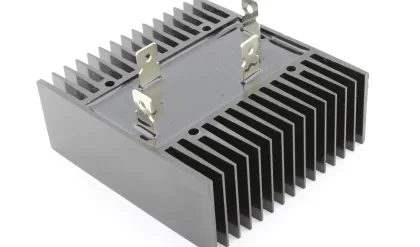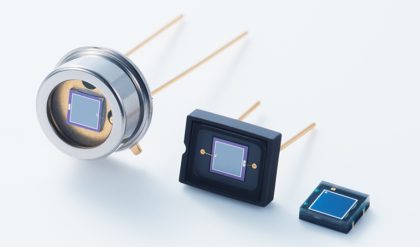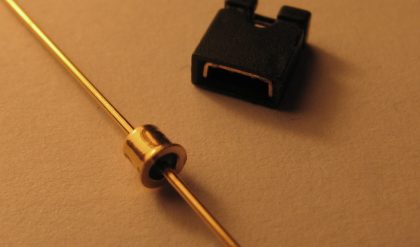An amplifier is an electronic device or circuit which is used to increase the magnitude of the signal applied to its input

Amplifier is the generic term used to describe a circuit which produces and increased version of its input signal. However, not all amplifier circuits are the same as they are classified according to their circuit configurations and modes of operation. In “Electronics”, small signal amplifiers are commonly used devices as they have the ability to amplify a relatively small input signal, for example from a Sensor such as a photo-device, into a much larger output signal to drive a relay, lamp or loudspeaker for example. There are many forms of electronic circuits classed as amplifiers, from Operational Amplifiers and Small Signal Amplifiers up to Large Signal and Power Amplifiers. The classification of an amplifier depends upon the size of the signal, large or small, its physical configuration and how it processes the input signal, that is the relationship between input signal and current flowing in the load.
The type or classification of an Amplifier is given in the following table.
Classification of Signal Amplifier
| Type of Signal | Type of Configuration | Classification | Frequency of Operation |
| Small Signal | Common Emitter | Class A Amplifier | Direct Current (DC) |
| Large Signal | Common Base | Class B Amplifier | Audio Frequencies (AF) |
| Common Collector | Class AB Amplifier | Radio Frequencies (RF) | |
| Class C Amplifier | VHF, UHF and SHF Frequencies |
Amplifiers can be thought of as a simple box or block containing the amplifying device, such as a Bipolar Transistor, Field Effect Transistor or Operational Amplifier, which has two input terminals and two output terminals (ground being common) with the output signal being much greater than that of the input signal as it has been “Amplified”. An ideal signal amplifier will have three main properties: Input Resistance or ( RIN), Output Resistance or ( ROUT ) and of course amplification known commonly as Gain or ( A ). No matter how complicated an amplifier circuit is, a general amplifier model can still be used to show the relationship of these three properties.
Ideal Amplifier Model

The amplified difference between the input and output signals is known as the Gain of the amplifier. Gain is basically a measure of how much an amplifier “amplifies” the input signal. For example, if we have an input signal of 1 volt and an output of 50 volts, then the gain of the amplifier would be “50”. In other words, the input signal has been increased by a factor of 50. This increase is called Gain. Amplifier gain is simply the ratio of the output divided-by the input. Gain has no units as its a ratio, but in Electronics it is commonly given the symbol “A”, for Amplification. Then the gain of an amplifier is simply calculated as the “output signal divided by the input signal”.
Amplifier Gain
The introduction to the amplifier gain can be said to be the relationship that exists between the signal measured at the output with the signal measured at the input. There are three different kinds of amplifier gain which can be measured and these are: Voltage Gain ( Av ), Current Gain ( Ai ) and Power Gain ( Ap ) depending upon the quantity being measured with examples of these different types of gains are given below.
Amplifier Gain of the Input Signal

Voltage Amplifier Gain


Note that for the Power Gain you can also divide the power obtained at the output with the power obtained at the input. Also when calculating the gain of an amplifier, the subscripts v, i and p are used to denote the type of signal gain being used. The power gain (Ap) or power level of the amplifier can also be expressed in Decibels, (dB). The Bel (B) is a logarithmic unit (base 10) of measurement that has no units. Since the Bel is too large a unit of measure, it is prefixed with deci making it Decibels instead with one decibel being one tenth (1/10th) of a Bel. To calculate the gain of the amplifier in Decibels or dB, we can use the following expressions.
· Voltage Gain in dB: av = 20*log(Av)
· Current Gain in dB: ai = 20*log(Ai)
· Power Gain in dB: ap = 10*log(Ap)
Note that the DC power gain of an amplifier is equal to ten times the common log of the output to input ratio, where as voltage and current gains are 20 times the common log of the ratio. Note however, that 20dB is not twice as much power as 10dB because of the log scale. Also, a positive value of dB represents a Gain and a negative value of dB represents a Losswithin the amplifier. For example, an amplifier gain of +3dB indicates that the amplifiers output signal has “doubled”, (x2) while an amplifier gain of -3dB indicates that the signal has “halved”, (x0.5) or in other words a loss. The -3dB point of an amplifier is called the half-power point which is -3dB down from maximum, taking 0dB as the maximum output value.





